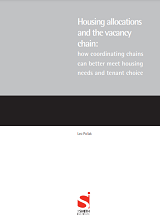Housing allocations and the vacancy chain: how coordinating chains can better meet housing needs and tenant choice

This report, published by The Smith Institute, is an exploration into the factors influencing vacancy chains in London’s social housing, covering general needs stock held by councils, ALMOs and housing associations, with interplays from supported and specialist housing.
The report is in five sections, including a set of recommendations.
The first sets out the backdrop to the problem with social housing need rising and overall lettings having fallen then plateaued, and examines the previous attention given to vacancy chains and some of limited work on housing mobility.
It references Housing LIN Factsheet (No 33), Pretty Vacant: Vacancy chains and Extra Care Housing. Stimulating local housing markets, that considered how the development of extra care housing can have a strategic impact on the better functioning of local housing markets by creating additional mobility within the market.
The fourth section examines – in a situation of scarcity – the ways different categories of housing need can come into conflict depending on the relative priority given in different boroughs’ allocation schemes. It also explores the different barriers to chain-maximising and the undersupply of chain-making for older people’s and family-sized housing.
Taken together the sections are intended to stimulate debate across nominating authorities, planners and social housing funders in influencing bedroom mix and housing types given in development programmes and planning policies, grant-giving criteria for new social and affordable housing.
The report seeks to shape new policies and practices for letting more good quality, secure and affordable homes to more households in priority housing need.
